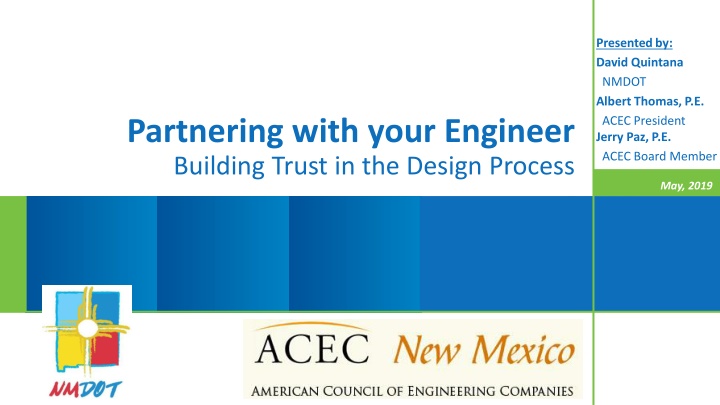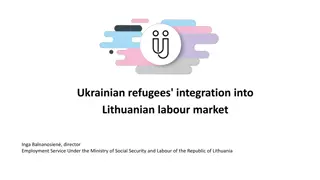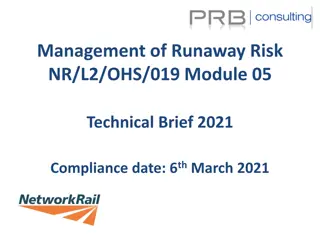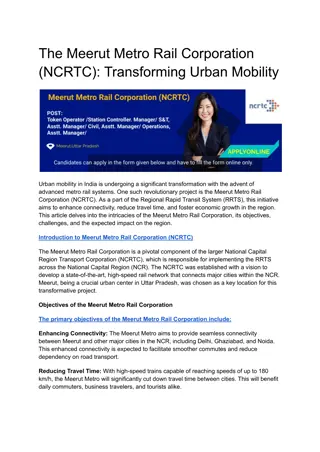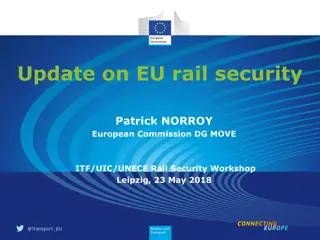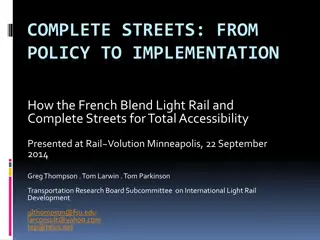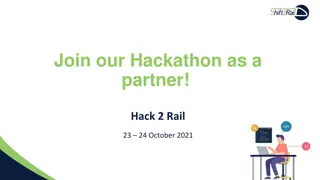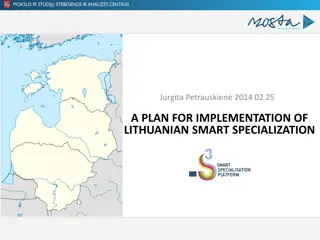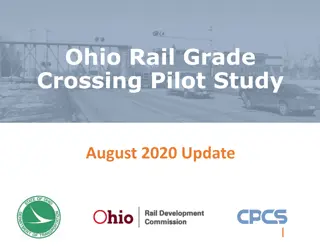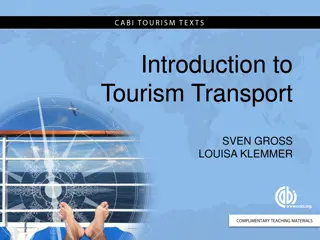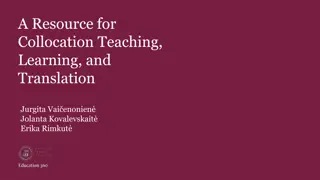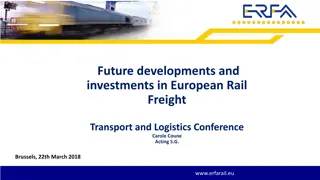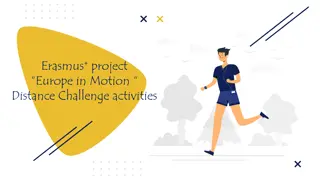Progress and Challenges in Rail Baltica Project - Lithuanian Perspective
Rail Baltica project in Lithuania has seen major developments in 2016, with defined routes, secured EU funding, and construction contracts launched. Challenges and opportunities include smooth project implementation, harmonization of plans among Baltic states and Poland, securing EU funding beyond 2020, and addressing the business case and security implications of Rail Baltica.
Download Presentation

Please find below an Image/Link to download the presentation.
The content on the website is provided AS IS for your information and personal use only. It may not be sold, licensed, or shared on other websites without obtaining consent from the author.If you encounter any issues during the download, it is possible that the publisher has removed the file from their server.
You are allowed to download the files provided on this website for personal or commercial use, subject to the condition that they are used lawfully. All files are the property of their respective owners.
The content on the website is provided AS IS for your information and personal use only. It may not be sold, licensed, or shared on other websites without obtaining consent from the author.
E N D
Presentation Transcript
Presented by: David Quintana NMDOT Albert Thomas, P.E. ACEC President Jerry Paz, P.E. ACEC Board Member Partnering with your Engineer Building Trust in the Design Process May, 2019
Key Presentation Topics The Value of Engineering Partnership Procurement of Engineers Legislation Governing Selection Process Project Scope Development Factors that go into Engineering Fees Engineering Contracts
Standard Contractual Relationship OWNER: Federal, State, or Local Government Secondary Parties (Contractor, Engineer) do not have contractual relationships with each other 3
Engineer vs. Contractor Engineer s are only given problems with no clear solution. Engineer must work within physical, natural & regulatory boundaries. Engineer must evaluate alternative solutions & make selection. Engineer should consider innovation. Engineer must convey solution to contractor (Plans & Specifications). 4
Engineer vs. Contractor Contractor has full set of instructions (plans and specifications) developed by Engineer to achieve solution. Contractor must select means, methods, and techniques to construct solution. Field conditions may require engineer to modify solution. 5
Owner Engineer Partnership Owners who actively partner with Engineer have the best opportunity to influence cost The earlier the Owner provides Engineer with input, the greater opportunity to save cost Owner shared information allows for effective decision making of solutions 6
Planning for Success Trust between Owner & Engineer allows parties to innovate and better collaborate Partnerships minimize design changes and construction changes Partnerships hold all parties accountable for continuous improvement without threat 7
FUNDING OPPORTUNITIES State-LGRF, MAP, CAP, School Bus Routes, Legislative. Federal- TAP, HSIP, CMAQ 8
Procurement of Professional Services 9
Procurement Qualifications-Based Selection or QBS Brooks Act Enacted by Congress in 1972 Established a QBS process for federal agencies when procuring architectural and engineering services Places the emphases on technical qualifications and competence rather than cost Projects with Federal Funds, regardless of Home Rule, required to follow 10
Legislation State Law requires that professional design services be procured through the Qualifications-Based Selection (QBS) process for local public works projects New Mexico State Procurement Code Section 13-1-120 Professional Services: Engineers, Architects, Landscape Architects, Surveyors Local Public Works Project: a project of a local public body; $60,000 or more for architectural or engineering services; $20,000 or more for landscape architectural or surveying services Exception: Home Rule entities Entities must have in place a Procurement Code that replaces the State Procurement Code. 11
Qualification Based Selection (QBS) Competitive procurement process Engineers and architects submit qualifications to the procuring agency/owner Agency/owner assesses the expertise of each competing firm and compares them against each other The most qualified firm is selected to negotiate the project scope and associated fee QBS has been so successful at the federal level that it has been adopted by 44 states New Mexico added surveying and landscape architecture 12
Utilizing PTAB PTAB(Professional Technical Advisory Board) Assists agencies/entities in developing RFPs to ensure compliance with State Procurement Code Helps in the selection and hiring of design professionals through the QBS process Any local public body which does not have on staff a licensed professional engineer, surveyor, architect or landscape architect shall have appointed to it....an individual to serve as a professional technical advisor Services are free! Contact: Dawn Tibbetts, Executive Director (505) 888-6161 PTAB@acecnm.org 13
The QBS Procurement Process STEP 1 The general scope of work is identified. STEP 2 The selection timeframe is established. STEP 3 The RFP is developed and published. STEP 4 A pre-proposal meeting and tour may be held to answer all questions at one time. STEP 5 Proposals are received and evaluated. All firms are informed of their rating and ranking. STEP 6 A short list of firms to be interviewed is determined (if necessary). STEP 7 Interviews are conducted and the firms are ranked for selection. STEP 8 All firms involved receive post- selection communication . A contract covering the negotiated items is executed. *Negotiations are conducted relative to scope, services, fee and payment schedules.
Scope and Fee Considerations Base fee on scope if scope is unclear or undefined, start with Preliminary Engineering Report or Design Report and amend contract to include design when report is completed Perform tasks that are not well defined on time and materials basis. Owners pays for work actually performed. Common examples are permitting and public meetings and support Separate milestones and approvals into smaller tasks or subtasks based on complexity of project. Examples are design milestones (30-60-90-Final) Make it easier to understand for everyone involved (Owner, Funding Agency, Stakeholders, and Engineer!)
The Total Scope of Services Affects the Engineering Fee Expanded regulatory requirements (ADA, NEPA, NPDES, EEO, etc.) Expansion in number of agencies having jurisdiction has grown Complexity of project approval processes has grown significantly Society has become more litigious, requiring a greater standard of care and increasing the level of accuracy and thoroughness needed. Additional studies and investigations, which were not normally completed in the past, are now prudent. Owners are demanding and expect a higher level of service
Primary Factors Affecting Engineering Fees The size and extent of project The complexity of the project The scope of services
Primary Categories of Engineering Services Basic Services Additional Services Reimbursable Expenses
Basic Services Services Typical to Every Project Project Management Preliminary Design Pre-Final Design Final Design Quality Control Bidding Phase Construction Phase Services
Basic Services Scope of Basic Engineering Services can vary significantly from project to project based on requirements of Owner and/or funding source Some Owners are more experienced than others Funding agency guidelines affect scope not all funding sources require the same things Owners rely on Engineer to provide guidance on what is needed to protect the Owner s interest
Additional Services Definition All other services required that are not included in Basic Services Easy, Right? Additional Services Requirements have increased due to the following factors Expectations of Owners and Funding Agencies concerning quality of services Regulations ADA, NEPA, NPDES, EEO require additional services by the Engineer Liability on Engineer and Owner required to protect owner and engineer (more studies and explorations)
Examples of Additional Services There are many types of additional services Common types are: Drainage studies and reports Construction Observation Public Involvement Operations and Maintenance Manuals Value Engineering Permitting Right of Way/Easement Acquisition Environmental Studies Preliminary Engineering Reports Geotechnical Exploration Surveying (design and construction staking) Subsurface Utility Exploration (SUE) Pavement Design Hydrogeologic services 24
Reimbursable Expenses Non-labor related expenses associated with engineering services Examples include: Gross Receipts Tax Mileage Printing costs Postage Fees for securing approvals Long Distance Charges Special equipment (GPS, sampling equipment, etc.) Lodging and meals Subconsultants
Reimbursables - Subconsultants Subconsultants are common on most projects. Can range from surveying, geotechnical, environmental, specialized engineering to teaming partners Engineer marks-up subconsultants costs to account for: Engineer incurs additional expense and liability using subconsultants Engineer s errors and omissions insurance increases in direct proportion to revenues Markup is defined as negotiated profit percentage commensurate with complexity and risk of project. Can be up to 10%
Contracting 28
Development Negotiation and Execution of Engineering Agreements Four components to the Engineering Agreement: Scope of Work Fee Proposal (man hour breakdown) Schedule Engineering Contract
Scope of Work Identify Owners goals and objectives Develop Scope Include the following: Description of tasks (basic services, additional services, reimbursables) Task descriptions should be as detailed as possible Tasks can be broken out into subtasks Include assumptions Include deliverables (type, quantity, format)
Fee Proposal Spreadsheet with man-hour breakdown - proposed team members and hours required to complete task Hours needed to complete each task depend on complexity of task Billing rates include the following Hourly wage wage paid for labor before taxes and deductions Overhead cost of doing business (benefits, facilities, etc.). Some agencies require an audit to justify overhead Profit Fee engineer receives over and above labor costs and overhead. Profit used as return on investment as well to purchase equipment, taxes, loans and profit sharing
Scope and Fee Negotiation Engineer meets with Owner to negotiate scope and fee Funding agency may also review scope and fee Fee should be negotiated based on scope - Engineer bases his fee on the scope and level of effort to complete task Reductions in fee = Reduction in scope Most tasks are budgeted as lump sum and billed based on percentage complete
Design Contracts NMED, USDA, EPA, DFA Coordinated with ACEC Shttps://www.env.nm.gov/construction- programs/cpb-forms-and-documents/#CPB- EngineeringContractTemplateAndIncludedAtta chments Industry Standard EJCDC Integrates Study, Design, Bidding, and Construction Documents Funding Agency Edition 33
Construction Phase Services Range in Services depending on clients needs Full Construction Observation, Inspection, and Testing Partial Oversight or Staff Augmentation Technical Support from Designers during Construction Funding agency has specific documentation requirements that could affect reimbursement if not followed Assist with Implementation, Interpretation of Specifications and Design Plans, Review Pay Estimates and Change Orders
Use of On-Call Contracts Statutory Limits $6 million over 4 years $500,000 any single contract Cooperative Education Services (CES) Expanded beyond schools Private Entity Not always applicable 35
